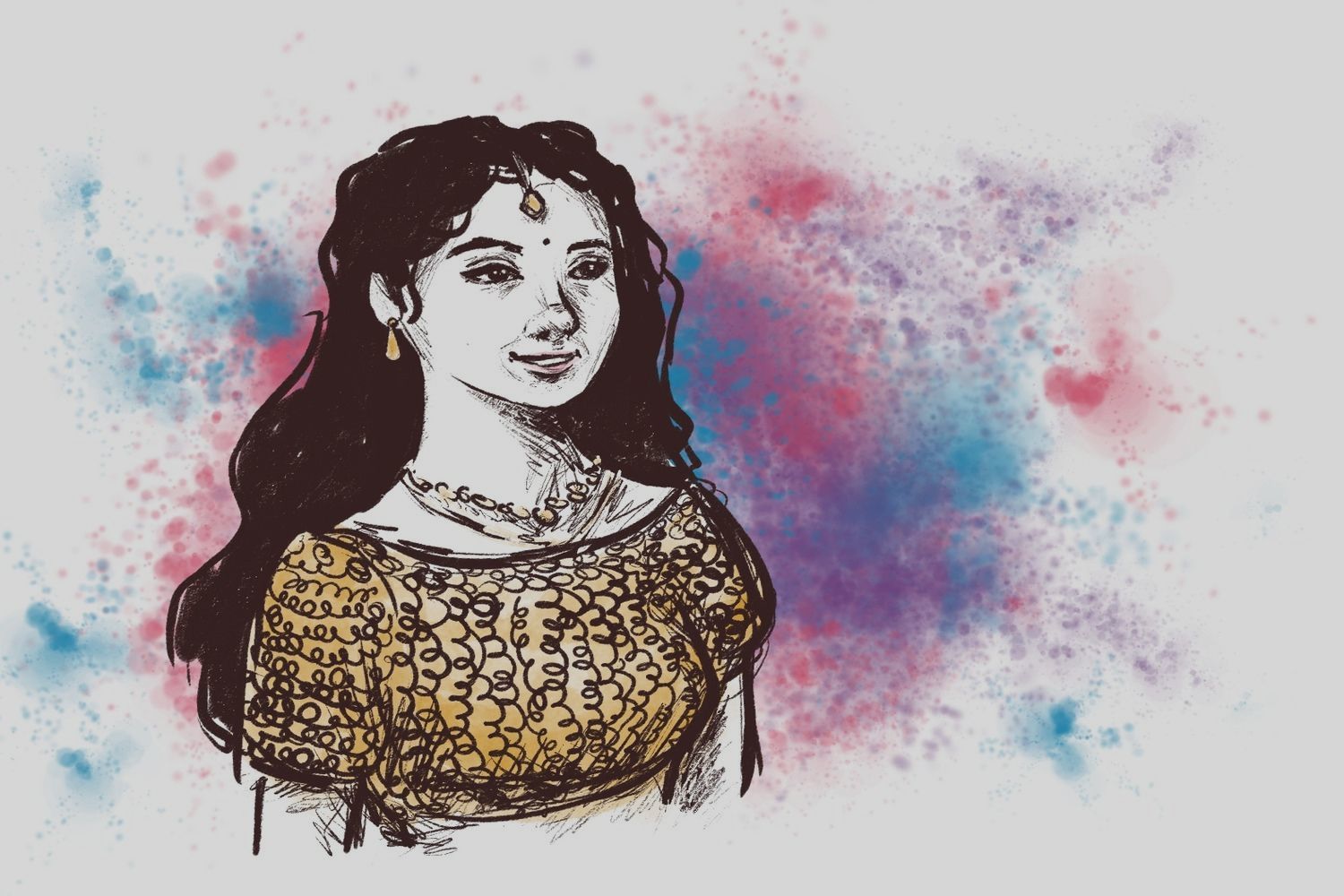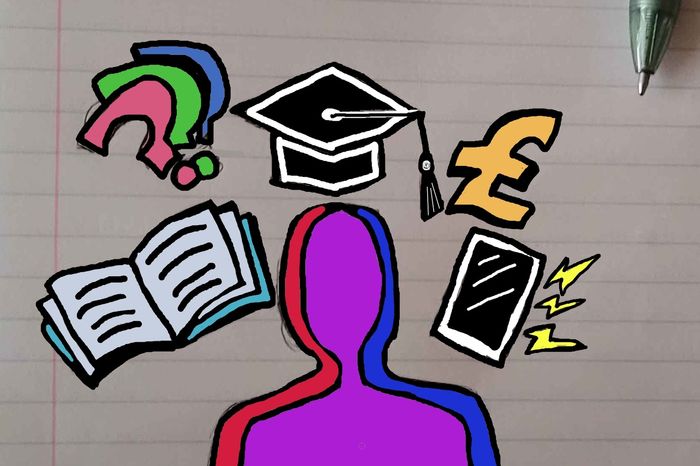From her hotel room across the Atlantic, Avantika joins the Zoom call (following a brief struggle to get the tech working from both of us), wearing her classic black bindi and eyeliner. She’s sitting on her bed, the only slot of free time she has before her next event now being taken up by my interview. Only nineteen (six months younger than me, in fact), her life has been a whirlwind of time slots. She graduated at thirteen and was constantly doing things: singing, dancing, and acting all over Indian media. Now, she’s a student at Columbia University, balancing lectures and red carpets. “I was homeschooled for middle school and went to a real high school,” Avantika shares. This dual experience gave her a unique perspective on the social aspects of schooling: “I had enough of a social life working in the industry. Most of my friends were actors,” she explains. The transient nature of friendships in the acting world, where people part ways for different projects, is her norm.
She’s now had to take time off because Columbia “is quite rigid in attendance” compared to her high school, which had “flexibility and allowed me to submit coursework online”. Previously, she would borrow notes and go “straight to the library after an event,” but the lifestyle quickly became “very hectic and unsustainable, especially when doing press tours or shooting”. However, overall, she doesn’t think that balancing auditions and academia is impossible. I ask her if socialising is strange at all: “[it] really doesn’t feel like that crazy of a thing”. Humbly, she asserts that, “I had to graduate when I was thirteen for my career, but nobody said I did it well,” claiming that the student body at Columbia is “incredibly accomplished”.
“Assimilation was a big thing in a school where everyone was Asian. Everyone had dyed hair, but my mom sent me to school with oil in mine”
However, she reveals that she “never had a social life in school […] I was heavily bullied in elementary and early middle school before I really came into my own.” Her school, Challenger, has a reputation for pushing students to their limits: “Kids were really intense and competitive. I don’t blame them; their family lives were high-pressure.” But both she and her parents believed that, though education was important, it was never worth sacrificing her well-being for. Already, the differences between her and her peers were showing: “In Silicon Valley, a lot of these families believed education was worth sacrificing these things for.” However, the bullying she faced was rooted in cultural assimilation as well; she was at odds with the dominant cultural practices in her area. “Assimilation was a big thing in a school where everyone was Asian. Everyone had dyed hair, but my mom sent me to school with oil in mine.” At the tender young age of thirteen, she “thought the world was going to end. But it didn’t. And I wish I’d had the friends I have at college now, back then.”
I ask her how she managed to be so brave then, openly showcasing her culture out on the red carpet, in the very heart of American beauty standards and ideals. “My journey of openly embracing my culture has been up and down,” she confides. Though she’s always been close to her faith and culture, in an industry centred so much around public image, there has been a lot more curation around which aspects of herself she’s shown to the world. In India, of course, this was not an issue, but in the early years of her career in America, she worried she might look “too brown” if she wore a bindi and sari. “There was a focus on being ethnically ambiguous. It was not a plus point to look definitively ethnic.” She found herself watering her looks down so that she, like many other young women of colour, could look “sort of ethnic”. As her career progressed, Avantika grew tired of the facade: “I was getting enough traction and callbacks, and honestly, I’m not passing for anything other than Indian.” Now, she is able to combine cultures, openly wearing her mother’s saris on the red carpet – a powerful statement of her identity and heritage. I ask if she ever watches her own TikTok edits, and she bursts out in peals of embarrassed laughter: “I do! My friends send them to me – and it is such a luxury to look at them if I’m having guy trouble or feeling down about myself.”
“There was a focus on being ethnically ambiguous. It was not a plus point to look definitively ethnic”
Avantika’s roles often challenge stereotypes and push boundaries. Her role in Big Girls Don’t Cry is a significant departure from the typical Bollywood heroine: “It was not heroine material. I played a more masculine-leaning character with no makeup,” she explains. I ask her about the show’s reception in India, and she tells me that, despite the “damaging perception that Indian audiences are regressive, there was no hesitation about an audience being ready to receive the show.” She laments that the Western narrative sometimes follows that Indian people can be very orthodox and traditional but that “audiences have opened up to the things that they’re willing to receive”. However, career-wise, she is more uncertain: “When you want to make a career in Bollywood, the trajectory is to start as a beautiful, fair, glamour doll. But here, there was no makeup or singing and dancing, and I looked South Indian. And so, I guess there was hesitation in overcoming that fear, more than how our audience is going to receive the material covered.”
Finding resonance with her personal experiences and values has helped her get into character for these vastly different roles, from Mean Girls’ Karen to Leah in Big Girls Don’t Cry. “I remember reading my old diaries for Big Girls Don’t Cry. The struggles felt very familiar.” To learn to play these characters, she would consume as much media from the respective genres as possible and immerse herself in the roles.
Our interview is momentarily interrupted by the arrival of her stylist, there to drop off Avantika’s outfit (a beautiful floor-length black number) for the premiere of her latest movie Tarot. Its arrival reminds me suddenly of just how completely packed her schedule is. She returns with a smile, ready to continue our chat, seemingly unfazed by her lifestyle of constant deadlines and events. I suppose it goes to show that she really has grown up in the midst of celebrity life.
The conversation turns to her cinematic influences and inspirations, the main one she cites being Viola Davis. I ask her the classic question: if she could make any film with three people starring in the cast, who would they be? She decides she’ll be the fourth member and her main cast would be Ayo Edibiri, Jack Black, and Dev Patel: “They’re very in the zeitgeist – I think they’d be so iconic together.” She hopes that she might one day find herself working with these influences of hers, in front of the camera or behind it. Inspired by the people around her, she tells me that all that she has already accomplished is only the beginning of her creative debut both on and off-screen: “I feel like I’m still tasting everything.”


